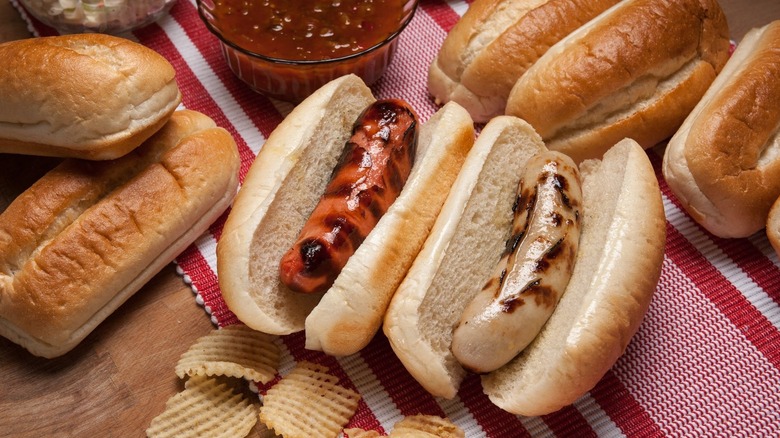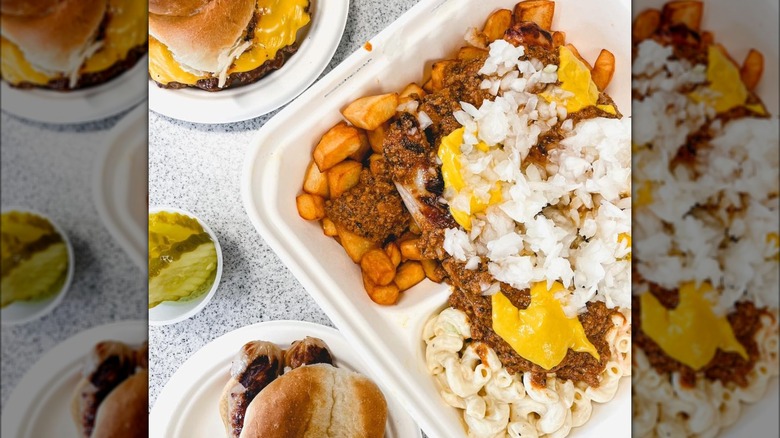Why Are Some Hot Dogs White?
When you think of a hot dog, images of a pinkish-red, snappy sausage nestled into squishy buns probably come to mind. A white frank may not even be on your radar unless you are from Rochester, New York or an expert on regional hot dog styles. If you're unfamiliar with this type, you may find yourself in the middle of the sausage versus hot dog debate — they look an awful lot like bratwurst, after all.
Known as white hots or porkers, these meaty guys are made out of a combination of pork, beef, and veal, and they have pale, gray-white color. Once cooked, the ones with natural sausage casings turn crackly and brown on the outside, but skinless options are also available. That means that the casing has already been taken off after cooking and before being packaged, so the texture is softer. Either way, the hot dogs maintain a creamy white look on the inside.
The light coloring is primarily a result of the meat being uncured and unsmoked. When meats are cured, the addition of nitrates causes a chemical reaction to occur, which changes the color of raw meat to a bright pink — consider ham, bacon, and yes, most hot dogs. Smoking also darkens the color of meat to brown or gray. Using veal in the mix keeps the color pale as well. Veal are young cows, and when they are fed only milk, the meat maintains a whitish color.
The history of white hots
This style of white hot dog was first made in the United States by German immigrants in the early 1900s. Originally, they were a more economical option because they included quite a bit of bread as a filler, which also contributed to the characteristic white color. Frederick Tobin, who ran the Tobin Packing Company in Upstate New York for decades, said that the blend for the sausages previously contained as much as 50 percent bread, according to the Democrat & Chronicle.
Tobin went on to improve the recipe by focusing on the quality of the meat and cutting out fillers, but the color stayed the same. The now-defunct company popularized white hots, but these days, Zweigle's is well-known for supplying these particular sausages. Zweigle's considers itself to be one of the founding companies to sell white hots.
This pale style of hot dog is very similar to a Weisswurst — one of many German sausages from Bavaria. It is a veal and pork sausage that was invented sometime in the 1800s. Unlike white hots, these are not served in a bun. Weisswurst is cooked in water and typically eaten alongside a soft pretzel, sweet mustard, and, of course, a cold beer.
Traditional toppings for white hots
A classic Rochester, New York preparation for these white hot dogs includes a topping called meat hot sauce, Rochester hot sauce, or sometimes simply meat sauce. It is made by simmering ground beef with spices like cayenne pepper, cinnamon, cloves, allspice, and paprika. The white dog gets sandwiched into a soft, side-sliced bun, and topped with diced white onion, a couple of spoonfuls of the meat sauce, and a healthy squirt of yellow mustard. Sweet pickle relish, dill pickle relish, sauerkraut, slaw, and shredded cheese are other popular toppings.
Another traditional way to eat white hots is in a garbage plate. The original garbage plate is from Nick Tahou Hots. The restaurant trademarked the name, so you will also find this dish called a trash plate, Rochester plate, compost plate, and more at many other establishments. This gargantuan spread includes home fries or french fries, baked beans, macaroni salad, and your choice of protein — hamburger patties, Italian sausages, steak, chicken, white hots, or red hots. Red hots are a traditional beef and pork frankfurter.
Sausages or hots are usually split in half lengthwise and griddled cut side down. The whole thing gets topped off with that signature meat hot sauce, and often, yellow mustard and onions too. It's like all your favorite hot dog sides piled up on one big plate!



